Olaus Magnus’ monsterlijke schepsels
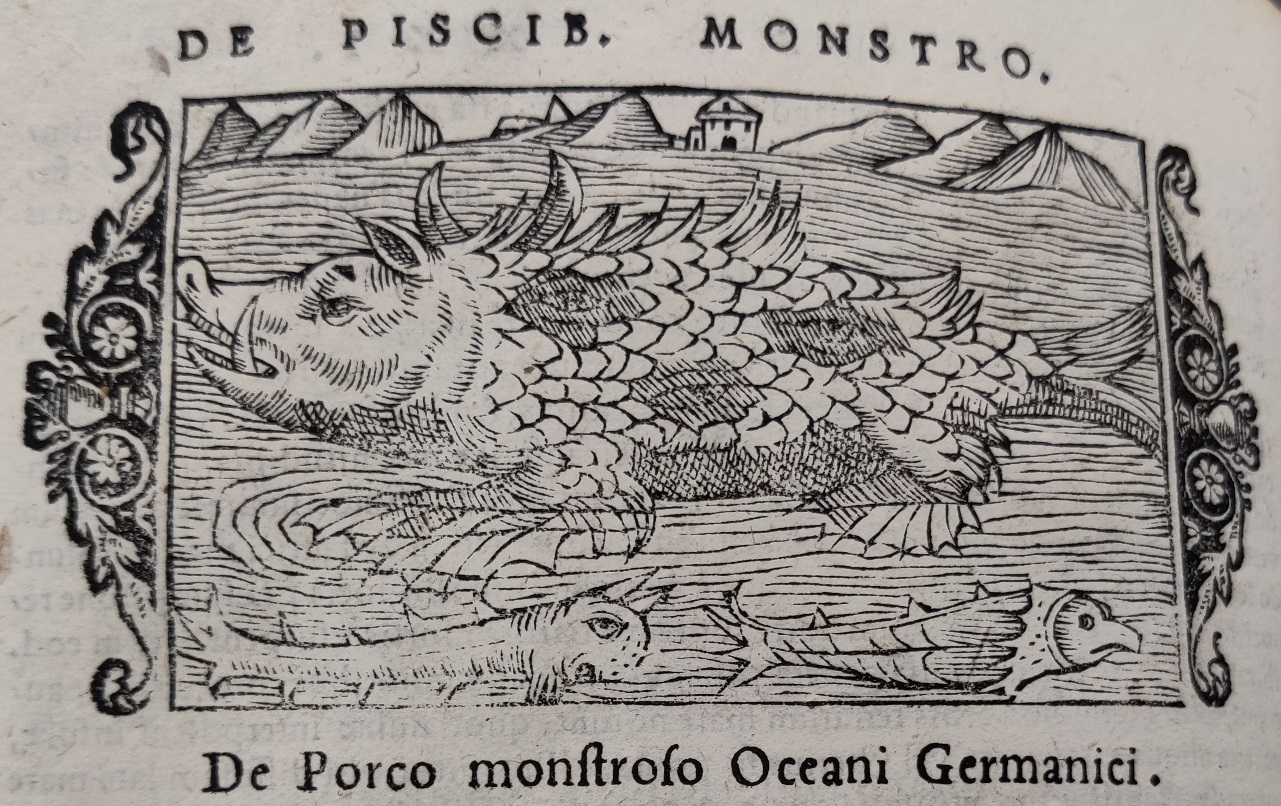
De Bijzondere Collecties van de Universiteitsbibliotheek Groningen en de Universiteitsbibliotheek Uppsala zijn verbonden door hun bezit van Olaus Magnus’ twee bekendste werken: zijn Carta Marina, in 1539 in Venetië gedrukt en nu in het bezit van de Universiteit van Uppsala, en zijn boek Geschiedenis van de Noordelijke Volkeren (Historia De Gentibus Septentrionalibus, Earumque Diversis Statibus, Conditionibus, Moribus, Ritibus, Superstitionibus, Disciplinis), in 1555 in Rome gedrukt, waarvan de Rijksuniversiteit Groningen een exemplaar bezit. De twee objecten zijn nauw aan elkaar verwant en deze relatie wordt duidelijk wanneer we kijken naar een van de interessantste aspecten van beide werken: hun nadruk op zeemonsters.
Olof Månsson, later bekend als Olaus Magnus (1492-1557), werd geboren in Linköping, Zweden en is voornamelijk vermaard door zijn omschrijvingen van de ‘noordelijke landen’, de volkeren die daar leven, hun gebruiken, dagelijkse leven en (volks)geloof. Nadat hij enkele jaren door Scandinavië en Noord-Europa had gereisd, bracht de katholieke Magnus het laatste deel van zijn leven in Italië in ballingschap door, nadat de Reformatie in Zweden voet aan grond had gekregen [1]. Olaus Magnus besloot om op basis van zijn persoonlijke ervaringen, literaire bronnen en verhalen ‘van horen zeggen’ zijn twee belangrijkste werken te creëren. Magnus was een van de eersten die een accurate en gedetailleerde kaart van de volledige Scandinavische regio maakte en de eerste die een systematisch (bijna encyclopedisch) overzicht schreef over alle aspecten van de landschappen en volkeren van dit gebied. In Magnus’ tijd waren de noordelijke landen vrij onbekend bij de meeste Zuid-Europeanen [2]. In zijn persoonlijke aantekeningen geeft Magnus aan dat hij de wonderlijke dingen wil beschrijven, zowel op het land als in de zee, die in de noordelijke landen kunnen worden waargenomen en vrijwel onbekend waren bij de Griekse en Latijnse auteurs [3]. Door middel van zijn Carta Marina en Historia De Gentibus Septentrionalibus wilde Magnus de onjuiste weergave van het Noorden herstellen die op eerdere kaarten werd aangetroffen. Daarnaast hoopte de vrome katholiek Magnus de Kerk te laten zien dat het waardevolle en interessante Noorden verloren was gegaan aan het lutheranisme en hiervan dringend verlost moest worden [4].
Magnus’ Carta Marina kan worden gezien als een van de meest bijzondere vroegmoderne kaarten, aangezien het lange tijd de accuraatste kaart van Scandinavië bleef en een model vormde voor tal van latere cartografen [5]. Met een afmeting van in totaal 170 x 125 cm was de Carta Marina een van de grootste kaarten die in de zestiende eeuw werd gedrukt. De kaart was uit negen verschillende vellen samengesteld. In tegenstelling tot de meeste andere kaarten was de Carta Marina een houtgravure en geen kopergravure. De kaart zelf is verdeeld in negen secties (A tot en met I) en bevat ook een legenda. De Carta Marina is opmerkelijk gedetailleerd: de kaart omvat niet alleen een geografische weergave van het gebied, maar Magnus heeft zijn weergave van het noorden gevuld met talloze afbeeldingen, waaronder afbeeldingen van flora en fauna, van gebouwen en schepen en van individuen en groepen mensen.
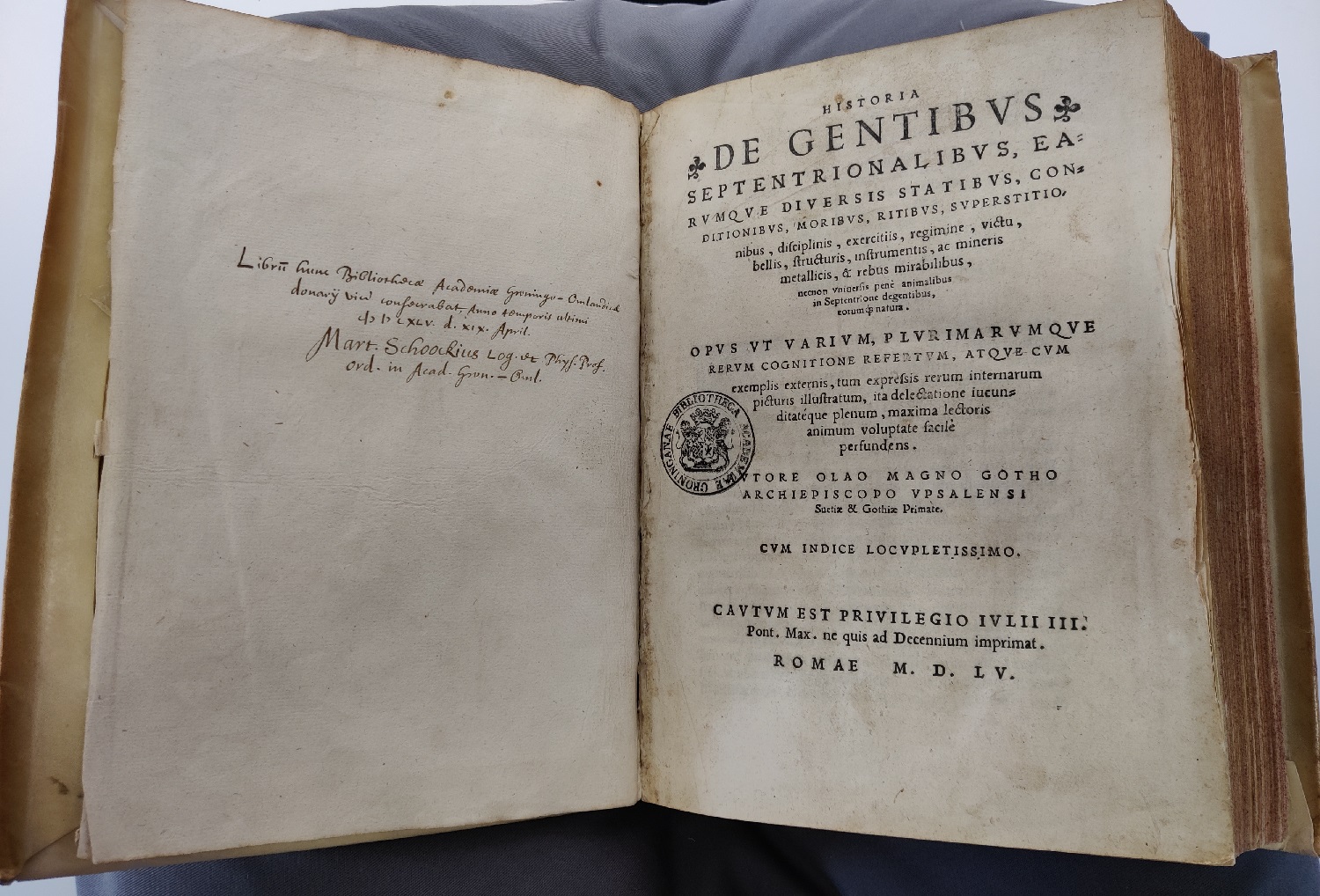
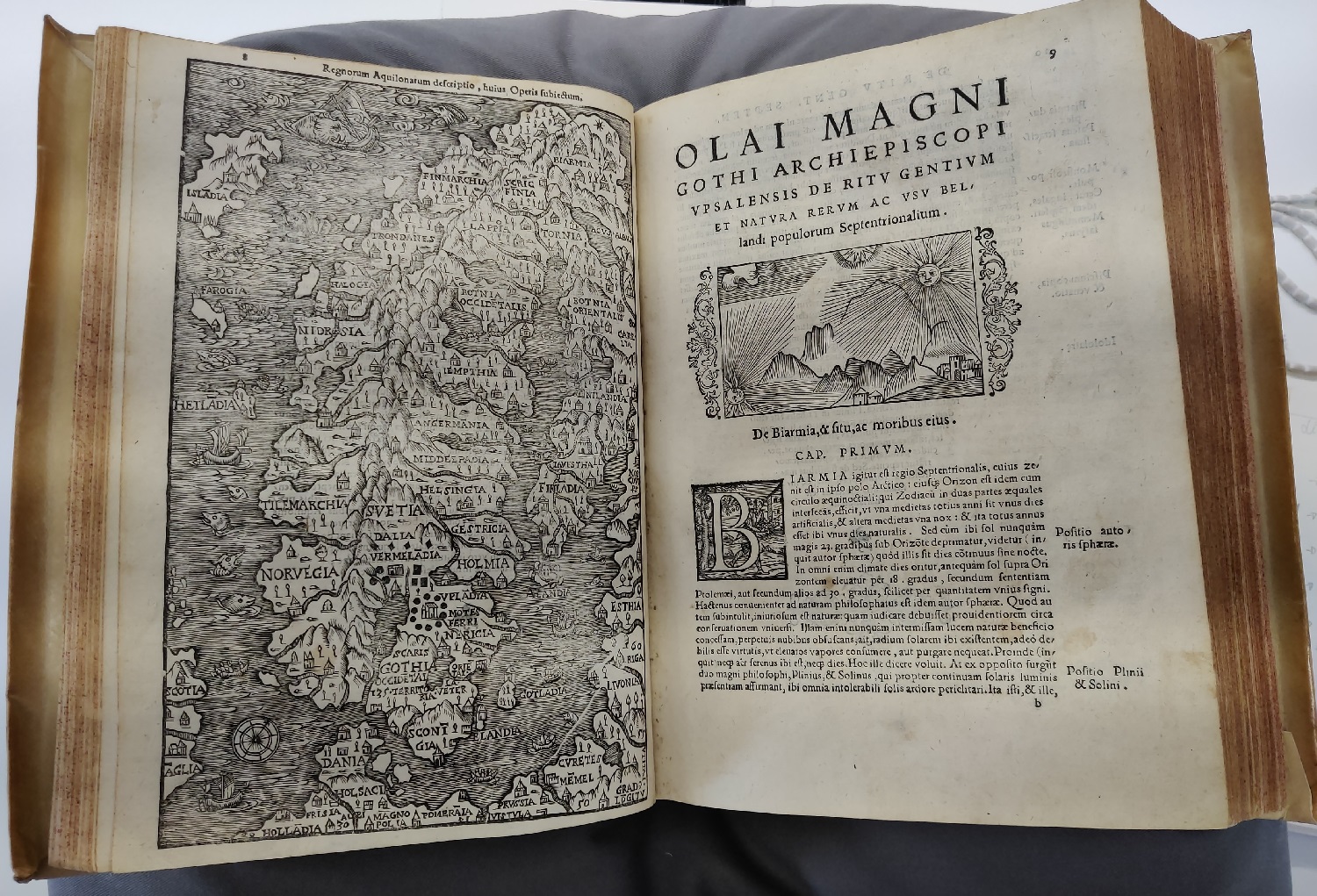
Magnus’ Historia De Gentibus Septentrionalibus [zie afb. 2] moest in eerste instantie dienst doen als een kort aanvullend commentaar op de Carta Marina, maar eindigde als een encyclopedische beschrijving van de noordelijke regio's. Het boekwerk werd zo lang dat het in 22 ‘boeken’ werd opgedeeld, die een paar honderd hoofdstukken omvatten. De Historia werd in het Latijn geschreven en in 1555 in Rome uitgegeven, waarna latere edities in het Duits, Italiaans, Nederlands en Engels volgden [6]. In zijn Historia verzamelde Magnus alle (min of meer) relevante informatie over de gebieden en volkeren die hij omschreef, variërend van informatie over oorlogen en koninklijke bloedlijnen tot gedetailleerde beschrijvingen van volkeren en hun specifieke gewoontes, en van historische gebeurtenissen tot meteorologische informatie. Hoewel een deel van zijn informatie irrelevant of rommelig geordend lijkt, heeft Magnus in grote lijnen geprobeerd een zekere mate van coherentie in zijn enorme opgebouwde kennis te bereiken door de ‘boeken’ en hoofdstukken aan verschillende onderwerpen te wijden [7]. Wanneer de Carta Marina en de Historia naast elkaar worden gelegd, wordt het thematische en grafische verband tussen de twee werken direct duidelijk. De Historia bevat een kleine, vereenvoudigde versie van de Carta Marina tussen de Index en het begin van de lopende tekst [zie afb. 3]. Bovendien zijn circa honderd afbeeldingen op de Carta Marina als een bijna exacte kopie herhaald in de Historia [zie afb. 4-6]. De afbeeldingen staan zonder uitleg of context op de Carta Marina, maar in zijn boek legt Magnus gedetailleerd uit wat de afbeeldingen op de kaart voorstellen en vult deze beschrijvingen aan met relevante informatie [8].
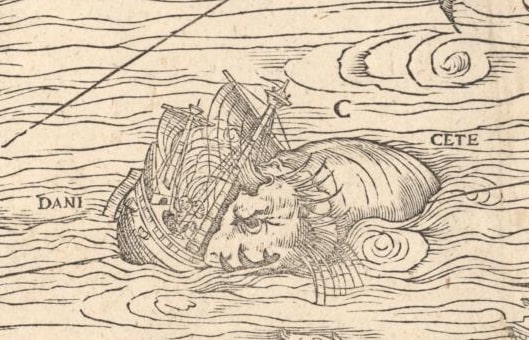
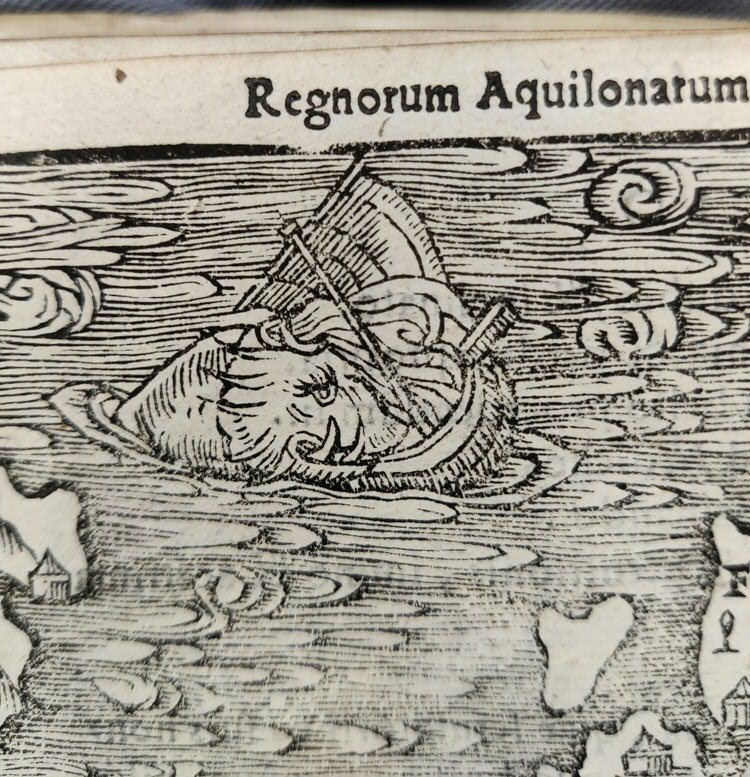
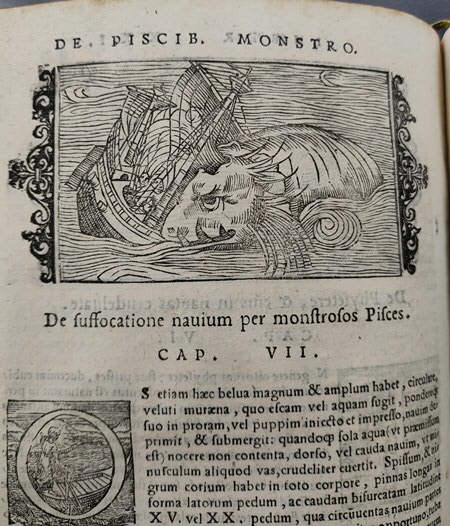
Magnus’ werk legt opmerkelijk veel nadruk op water, in tegenstelling tot veel eerdere kaarten. Waar op andere kaarten zeeën en oceanen verbannen zijn naar de marges, bestaat de helft van Magnus’ Carta Marina uit water en de wezens en activiteiten die ermee verbonden zijn. De Historia bevat talloze pagina’s gewijd aan water, met ‘boeken’ en hoofdstukken over zeehandel en zeeoorlog, zeewezens en visserij, en veel van deze hoofdstukken openen met een afbeelding die rechtstreeks van de Carta Marina lijkt te zijn geplukt. Deze relatie tussen de Carta Marina en de encyclopedische uitleg in de Historia is bijvoorbeeld duidelijk te zien in Magnus’ weergave van een van de meest tot de verbeelding sprekende (en misschien surrealistische) elementen op zijn kaart: de zeemonsters die zijn afgebeeld in de zee tussen Noorwegen en IJsland [zie afb. 7]. Magnus geeft talloze vissen en monsterlijke zeewezens weer op de Carta Marina en de Historia bevat hoofdstukken ‘Over Vissen’ en ‘Over Monsterlijke Vissen’, hoewel het onderscheid tussen de twee niet altijd even duidelijk is, met name op de Carta Marina. In de Historia wordt een deel van de schepsels behandeld als een ‘gewoon’ onderdeel van de lokale fauna, terwijl andere een morele of metaforische betekenis toegekend krijgen. Een fascinerend voorbeeld is Magnus’ behandeling van het ‘zeevarken’ [zie afb. 8-9].
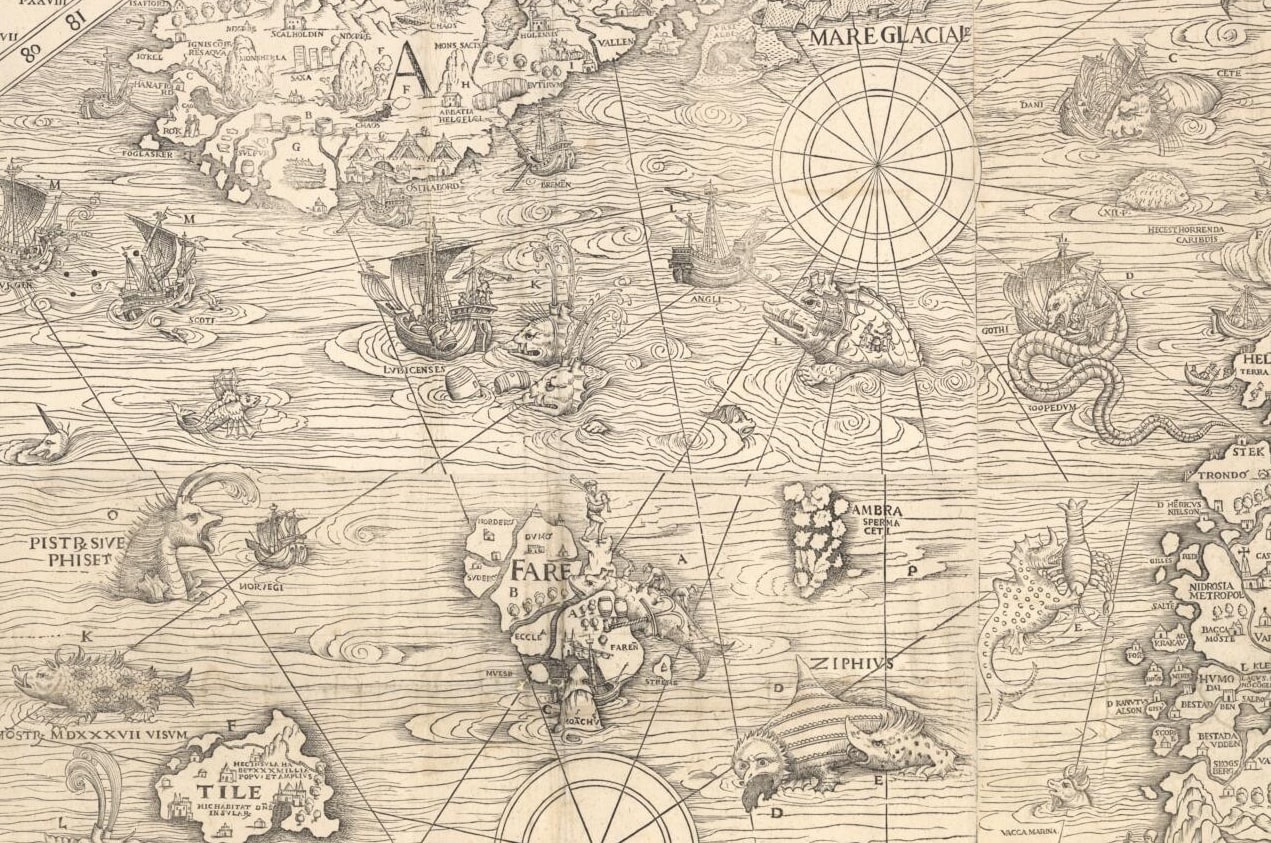
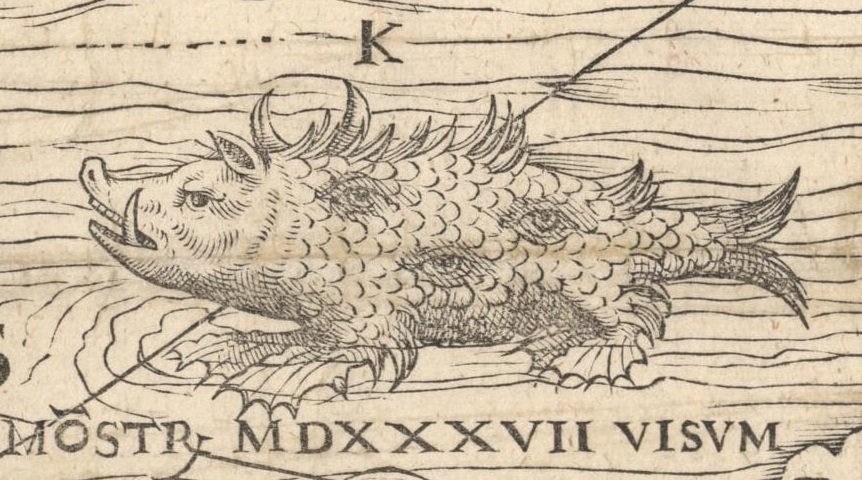
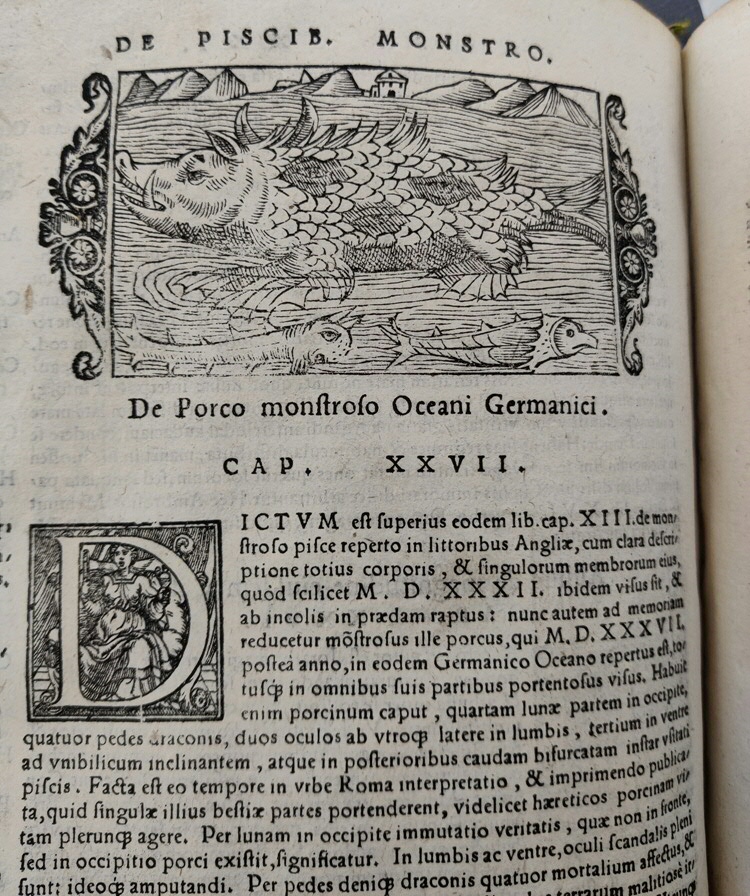
In de Historia beschrijft Magnus deze monsterlijke vis-varkenhybride als volgt:
“Het had het hoofd van een varken met een wassende maan op de achterkant, vier drakenpoten, een paar ogen aan beide kanten in zijn lendenen en een derde paar op zijn buik richting de navel; aan het einde had het een gevorkte staart zoals een normale vis. In de stad Rome werd in die tijd een interpretatie van het wezen gedrukt en uitgegeven, waarin de betekenis van de afzonderlijke onderdelen werd uitgelegd. Deze liet zien hoe ketters over het algemeen een varkensachtig bestaan nastreefden. De maan aan de achterkant van het hoofd was een symbool voor de vervorming van de waarheid, aangezien het op de achterkant van de nek groeide en niet op het voorhoofd van het varken. De ogen in zijn lendenen en buik zijn vol van verleiding en daarom moeten ze eruit gesneden worden. Als laatste symboliseren de vier drakenpoten de verschrikkelijk kwaadaardige verlangens en daden van de mensheid, die verdorven uit de vier hoeken van de aarde binnendringen en in de vis verschijnen alsof het een loerende schurk is” [9] (XXI: 27; Vol. 3, p. 1110) [10].
Dit wezen is eerder het meest letterlijk monsterlijke monster van de Carta Marina genoemd en zou de aanhoudende religieuze omwentelingen in de zestiende eeuw symboliseren. Het zeevarken geeft de dodelijke zonden lust en hebzucht weer, eigenschappen waarvan de vrome katholiek Olaus Magnus meende dat die inherent waren aan het lutheranisme, dat zich in het noorden snel verspreidde. Tijdens zijn verblijf in Italië raakte Magnus actief betrokken bij de Rooms-katholieke Contra-reformatie. Zijn persoonlijke overtuigingen worden daardoor in zijn kaart en boek weerspiegeld [11].
Het monsterlijke zeevarken was niet door Magnus zelf bedacht, maar was gekopieerd van een pamflet dat in 1537 in Rome werd uitgegeven. Door de religieuze omwentelingen in de zestiende eeuw werden theologisch-kritische en -satirische pamfletten steeds populairder. Het pamflet dat Magnus als zijn bron voor het zeevarken gebruikte, kan gezien worden als de katholieke tegenhanger van de populaire lutherse pamfletten, zoals de Uitbeelding van Twee Verschrikkelijke Figuren als het monnik-kalf en de paus-ezel door Philippus Melanchthon en Maarten Luther [12]. Hoewel de afbeelding op de Carta Marina slechts een zoveelste monsterlijke vis toont — een onderwerp dat zo populair was dat Magnus er een volledig ‘boek’ in zijn Historia aan wijdde — geeft de beschrijving in de Historia een diepere betekenislaag aan de afbeeldingen op de kaart.
Los van elkaar zijn Olaus Magnus’ twee belangrijkste werken uitzonderlijke wetenschappelijke en kunstzinnige creaties. Maar wanneer we de Carta Marina en de Historia als elkaars complement zien, gaan er deuren open naar nieuwe interpretaties.
Dat deze objecten terecht zijn gekomen waar zij nu zijn, in Groningen en Uppsala, is slechts toevallig. De Historia werd op 19 april 1645 door een van haar hoogleraren, Martinus Schoockius, geschonken aan de Universiteit van Groningen, zoals blijkt uit een contemporaine inscriptie op het schutblad [zie afbeelding 10]. De Carta Marina die tegenwoordig in het bezit van de Universiteit van Uppsala is, is één van de slechts twee exemplaren die nu bekend zijn. Tot het einde van de 19e eeuw dacht men dat alle kaarten die gedrukt waren tijdens Magnus’ leven spoorloos verdwenen waren, totdat een exemplaar werd gevonden op de afdeling Scandinavische Kaarten van de Hof- und Staatsbibliothek in München [13]. Een tweede kaart werd gevonden in de bezittingen van de Poolse verzamelaar Graaf Emeryk Hutten-Czapski, die contact opnam met de Universiteit van Uppsala en aan haar zijn exemplaar van de Carta Marina in 1962 in Genève verkocht [14]. De commentaren op beide kaarten, in het Latijn geschreven, laten duidelijk zien dat Olaus Magnus van plan was de twee kaarten in verschillende delen van Europa te laten circuleren. De kaart in Uppsala werd uitgegeven ter ere van de zeer doorluchtige Doge Pietro Lando, de Raad van Venetië en ‘tot het algemeen nut van de Christelijke wereld’ (quam ad laudem serenissimi Ducis Petri Landi Senatusque Venet. ac publicam christiani orbis utilitatem emitto). De kaart in München werd uitgegeven ter ere van de gevierde Germaanse en Gotische naties en ‘tot het algemeen nut van de Christelijke wereld’ (quam ad laudem inclite Germanice et Gothice nationis ac publicam christiani orbis utilitatem emitto) [15].
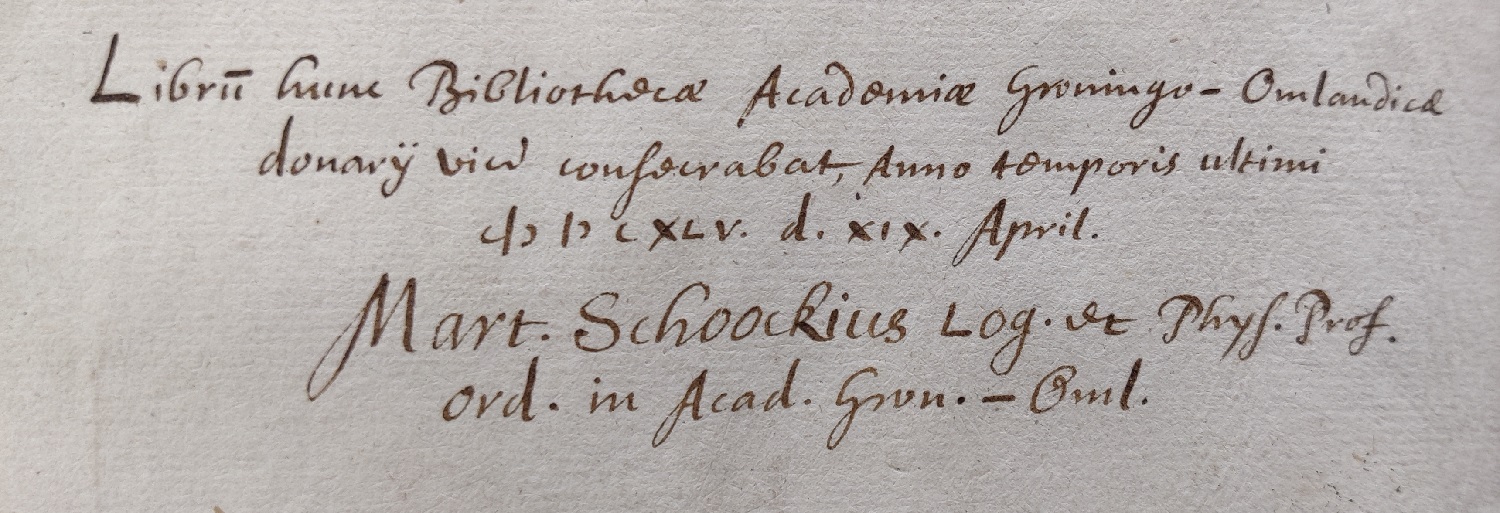
Olaus Magnus en zijn werk blijven interessant voor hedendaagse academici, met name door de artistieke en historische waarde van zijn kaart en boek. De combinatie van feitelijke informatie, de fantasievolle en metaforische weergave en de esthetische waarde zorgt ervoor dat Magnus’ werken eeuwen na hun schepping het publiek nog altijd voor zich innemen en laten verwonderen.
Noten:
- Elena Balzamo, Om den ”lyckliga slumpen”: Carta marinas öden och äventyr: Olaus Magnus’ (1492–1557): 4-5.
- Dario Del Puppo. “All the World is a Book: Italian Renaissance Printing in a Global Perspective”, Textual Cultures 6, no.2 (2011): 5.
- Leena Miekkavaara. “Unknown Europe: The mapping of the Northern countries by Olaus Magnus in 1539.” (2008): 5.
- Leena Miekkavaara. “Unknown Europe: The mapping of the Northern countries by Olaus Magnus in 1539.” (2008): 4.
- Elena Balzamo, “Om den ”lyckliga slumpen”: Carta marinas öden och äventyr: Olaus Magnus’ (1492–1557)”: 4-5.
- Harry B. Weiss. “Olaus Magnus, Credulous Zoologist, and Archbishop of the Sixteenth Century”, Journal of the New York Entomological Society 38, no, 1 (1930): 36.
- Barbara Sjoholm. “‘Things to be Marveled at Rather than Examined’: Olaus Magnus and ‘A Description of the Northern Peoples’”, The Antioch Review 62, no.3 (2004): 247.
- Barbara Sjoholm. “‘Things to be Marveled at Rather than Examined’: Olaus Magnus and ‘A Description of the Northern Peoples’”, The Antioch Review 62, no.3 (2004): 250.
- E. Sandmo. “Dwellers of the waves: Sea monsters, classical history, and religion in Olaus Magnus’s Carta Marina”. Norsk Geografisk Tidsskrift–Norwegian Journal of Geography 74 (2020): 245.
- Olaus Magnus, transl. Peter Foote, and Hakluyt Society. Description of the Northern Peoples, 1555. Volume Iii (Farnham, Surrey, England: Ashgate Pub, 2010): 1110.
- E. Sandmo. “Dwellers of the waves: Sea monsters, classical history, and religion in Olaus Magnus’s Carta Marina”. Norsk Geografisk Tidsskrift–Norwegian Journal of Geography 74 (2020): 239.
- E. Sandmo. “Dwellers of the waves: Sea monsters, classical history, and religion in Olaus Magnus’s Carta Marina”. Norsk Geografisk Tidsskrift–Norwegian Journal of Geography 74 (2020): 245.
- Elena Balzamo, Om den ”lyckliga slumpen”: Carta marinas öden och äventyr: Olaus Magnus’ (1492–1557) Biblis 37, 2007, 4-5.
- Lars Munkhammar. “När Carta marina kom till Uppsala; Från handskrift till XML: informationshantering och kulturarv: humanistdagarna vid Uppsala universitet” (2002), 61-64.
- Leena Miekkavaara. “Unknown Europe: The mapping of the Northern countries by Olaus Magnus in 1539.” (2008), 31-32.
Deze expositie is gemaakt door Madelief Albers en Sanna Nyholt voor de summer school Things That Matter in de context van U4Society Network waarin Groningen en Uppsala participeren.

